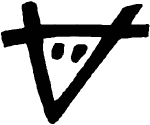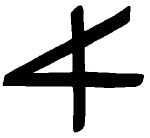
Phoenician: aleph (Ox)
From natural depictions several peoples developped simplified and abstracted pictorial depictions and symbols, which are called word-picture-writing or also picture-type.
The Phoenicians developped between 2000 and 1300 before Christ a consonant-type, which makes already foresee the latin characters used today.

simplified term of »aleph«

Roman Capitalis: Alpha
These characters were taken and widened by the Greeks about 1100 before Christ. They replaced some letters and added the vocals.
But their actual achievement was to give geometric shapes (square, triangle, circle) to the characters. This type-face matches largely with today's capital letters.
The Romans took the greek characters and shaped – carved in stone – a pure capital letter type. In this way, already in 4. to 2. century b. Chr., the Capitalis Monumentalis arised. She is the basis for today's roman capital letters.